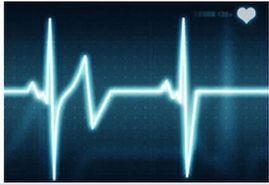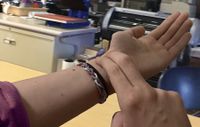Pulse Rate
Original Editor - Ayelawa Samuel Top Contributors - Ayelawa Samuel, Chelsea Mclene, Naomi O'Reilly, Lucinda hampton and Leana Louw
Introduction[edit | edit source]
Pulse/heart rate is the wave of blood in the artery created by contraction of the left ventricle during a cardiac cycle. The strength or amplitude of the pulse reflects the amount of blood ejected with myocardial contraction (stroke volume). Normal pulse rate range for an adult is between 60-100 beats per minute. A well-trained athlete may have a resting heart rate of 40 to 60 beats per minute, according to the American Heart Association (AHA).[1]
Types of Pulse rate[edit | edit source]
- Peripheral pulses that can be felt at the periphery of the body by palpating an artery over a bony prominence. Examples are carotid, radial and popliteal pulses
- Apical pulses which is a central pulse located on the apex of the heart that is monitored using a stethoscope.[2]
Factors that Influence Heart Rate[edit | edit source]
- Age
- Sex
- Emotions/stress
- Exercise
- Medication[2]
How to Check Pulse[edit | edit source]
Pulse site[edit | edit source]
- Temporal
- Carotid
- Brachial
- Radial
- Femoral
- Popliteal
- Dorsalis pedis[2]
It is easiest to take the pulse at the wrist. If you use the lower neck, be sure not to press too hard, and never press on the pulses on both sides of the lower neck at the same time to prevent blocking blood flow to the brain.
When taking your pulse:
- Using the first and second fingertips, press firmly but gently on the arteries until you feel a pulse.
- Begin counting the pulse when the clock's second hand is on the 12.
- Count your pulse for 60 seconds
- When counting, do not watch the clock continuously, but concentrate on the beats of the pulse.
- If unsure about your results, ask another person to count for you.
Parameters of Pulses[edit | edit source]
- Rate: Number of pulsation which could be Bradycardia (<60/minute) or Tachycardia (>100/minute)
- Rhythm: Time interval between pulse beats[2]
Bradycardia[edit | edit source]
Reduced pulse rate
Pulse Rate <60/min[3]
Indications of reduced pulse[edit | edit source]
- Infection (e.g. myocarditis)
- Complication of heart surgery
- Hypothyroidism
- Medication
- Inflammatory diseases such as rheumatic fever[4]
Symptoms[edit | edit source]
- Near-fainting or fainting (syncope)
- Dizziness or lightheadedness
- Fatigue
- Shortness of breath
- Chest pains
- Confusion or memory problems
- Easily tiring during physical activity
Types[edit | edit source]
There are two basic types of bradycardia:
- Sick sinus syndrome is common in elderly but can occur at any age. It occurs when the sinus node (the heart's own pacemaker) fails and does not reliably trigger heartbeats.
- Heart block is the interruption of the electrical impulses on their way to the ventricles and results in a slow. It can be partial or complete.
Risk factors[edit | edit source]
- Age
- High blood pressure
- Smoking
- Heavy alcohol use
- Recreational drug use
- Psychological stress or anxiety
Complications[edit | edit source]
- Frequent fainting spells
- Heart failure
- Sudden cardiac arrest or sudden death
Prevention[edit | edit source]
- Exercise
- Eat healthy diet
- Maintain healthy weight
- Don't smoke
- Avoid alcohol consumption.
- Keep blood pressure and cholesterol under control
- Manage stress
- Scheduled checkups
Tachycardia[edit | edit source]
Elevated pulse rate
Pulse Rate >100/min
Indications of elevated pulse[edit | edit source]
- Heart related conditions such as high blood pressure
- Poor blood supply to the myocardium due to coronary artery disease
- Thyroid disease (e.g. hyperthyroidism)
- Electrolyte imbalance
- Alcohol use
- Emotional stress[5]
Symptoms[edit | edit source]
- Shortness of breath
- Lightheadedness
- Rapid pulse rate
- Heart palpitations
- Chest pain
- Syncope
Types[edit | edit source]
- Atrial Fibrillation
- Atrial Flutter: Heart's atria beats very fast but at a regular rate.
- Supraventricular Tachycardia: Abnormal fast heartbeat that starts somewhere above ventricles.[6]
- Ventricular Tachycardia: Rapid heart rate that starts with abnormal electrical signals in the ventricles.
- Ventricular Fibrillation: It occurs when rapid, chaotic electrical impulses cause the ventricles to quiver instead of pumping necessary blood to the body.
Risk Factors[edit | edit source]
- Anemia
- Diabetes
- Heart disease
- Heavy alcohol use
- Heavy caffeine use
- High blood pressure
- Overactive or underactive thyroid
- Psychological stress or anxiety
- Sleep apnea
- Smoking
- Use of stimulant drugs
Complication[edit | edit source]
- Blood clots that can cause a stroke or heart attack
- Heart failure
- Frequent fainting spells or unconsciousness
- Sudden death
Prevention[edit | edit source]
- Exercise
- Eat healthy diet
- Maintain healthy weight
- Don't smoke
- Avoid alcohol consumption.
- Keep blood pressure and cholesterol under control
- Manage stress
- Scheduled checkups
Physiotherapy Management[edit | edit source]
The role of the physiotherapist is to monitor the heart rate during exercise, the intensity and safe exercise level. The pulse rate must be taking into account to determine the level of intensity exercise the patient can bear (light vs moderate vs heavy exercise intensity zone).[7][8]
Further Reading[edit | edit source]
References[edit | edit source]
- ↑ Live Science. What is normal heart rate? Available from: https://www.livescience.com/42081-normal-heart-rate.html (accessed 03/02/2020).
- ↑ 2.0 2.1 2.2 2.3 Susan B, Thomas J, George D. Physical Rehabilitation Sixth edition. USA: F.A. Davis 2014.
- ↑ Mangrum JM, DiMarco JP. The evaluation and management of bradycardia. New England Journal of Medicine. 2000 Mar 9;342(10):703-9.
- ↑ Mayoclinic. Bradycardia. Available from: https://www.mayoclinic.org/diseases-conditions/bradycardia/symptoms-causes/syc-20355474 (accessed 03/02/2020).
- ↑ Medtronic. About tachycardia (fast heartbeat). Available from: https://www.medtronic.com/au-en/your-health/conditions/fast-heartbeat.html (accessed 03/02/2020).
- ↑ Ganz LI, Friedman PL. Supraventricular tachycardia. New England Journal of Medicine. 1995 Jan 19;332(3):162-73.
- ↑ ATI Physical Therapy. Target Heart Rate and Exercise Available from: https://www.atipt.com/news/target-heart-rate-and-exercise (accessed 03/02/2020).
- ↑ Ekblom B, Kilbom Å, Soltysiak J. Physical training, bradycardia, and autonomic nervous system. Scandinavian journal of clinical and laboratory investigation. 1973 Jan 1;32(3):251-6.








